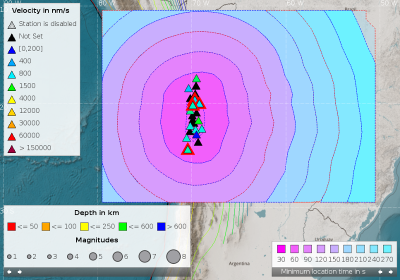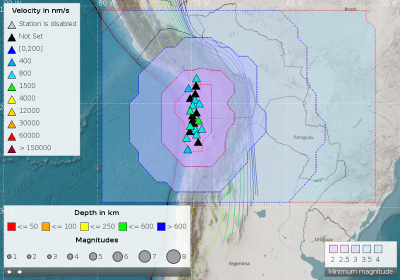npeval
Network performance evaluation
Overview
High-performance networks for earthquake monitoring
npeval provides SeisComP operators with up-to-date information about the current or expected performance of the monitoring network. It also reports significant changes in station quality (QC) parameters for delivery to network operators, personnel on duty, etc. npeval is therefore is an essential module to achieve and maintain an optimized monitoring system.
It generates
- Grids on maps with
- the minimum time required to locate seismic events,
- the minimum magnitude of seismic events for which the network is expected to deliver a location,
- Points or interest with
- S-P travel-time estimates as a proxy for early warning times
- QC reports for stations with significant changes which can be sent to any recipients using GDS or custom scripts.
The minimum time required to locate earthquakes can be updated dynamically and
shown on maps. Minimum magnitude of earthquakes that can be expected to be located
automatically.

The geometry of seismic networks and the quality of the involved sensor stations determine the capability to locate earthquakes within a specific time and for a particular magnitude range. When establishing seismic networks those design requirements are typically considered. During operation of the network the station quality parameters can change or stations even become unavailable. Such changes possibly require actions since they affect the earthquake monitoring performance. The monitoring performance must therefore be evaluated whenever possible.
npeval evaluates the seismic monitoring networks in real time. When executed before or during station setup, npeval can assist in designing optimum seismic networks.
The values are calculated for grid points within a configurable region. npeval takes into account network geometry and data quality control (QC) parameters such as noise or data delay. Upon significant changes, the times and the magnitudes are re-calculated. The output parameters can be stored as surfer GRD files, BNA polygons or PNG images. The GRD files and BNA polygons can be shown and dynamically updated on maps. For showing several GRD files on maps at once we recommend our mapmultigrid plugin.
The QC reports are generated in JSON format which can be processed further by custom grids or sent to basically any recipient and by any method, e.g., email, SM, social media, etc. using GDS.
DocumentationFeatures
Performance parameters and reporting in one box
npeval provides a toolbox to evaluate and report the network performance.
- Computes the minimum time required to locate a seismic event,
- Computes the minimum magnitude for which an automatic solution is expected,
- Reports parameter updates and significant changes in station quality (QC) for distribution via GDS or other tools.
- Automatically considers only stations used for the actual event detection or which are defined in tables,
- Dynamically considers enabled or disabled stations and excludes stations given in a file,
- Integrates in different processing pipelines
- Dynamically considers real-time changes in the station quality control (QC) parameters,
- Writes Surfer grids or BNA files which can be evaluated on maps,
- Highly customized and configurable:
- network geometry is derived from the monitoring configuration,
- minimum number of stations for locating earthquakes,
- region, grid interval and depths for considering earthquakes,
- delay added to the stations considering data transfer and processing - constant or from QC,
- traveltime table and interface,
- Earth model parameters for computing magnitudes
- random station removal simulating stations not having picks (commandline option),
- supported output formats: GRD, BNA, PNG,
- update interval.
Applications
Employ npeval to evaluate seismic monitoring networks for:
- Real-time network performance monitoring and reporting,
- Optimizing the setup of processing pipelines in SeisComP system,
- Network design planning before and during network operation.
Promotion
Approved by science
npeval has been demonstrated, promoted and discussed with scientists and the SeisComP community at international science conferences, e.g.:
D. Roessler, B. Weber, E. Ellguth, J. Spazier the team of gempa: Evaluierung der Qualität und Geschwindigkeit von Erdbebendetektionen in SeisComP3, 2017, Bad Breisig, Germany, AG Seismologie meeting
D. Roessler, B. Weber, E. Ellguth, J. Spazier the team of gempa: EVALUATION OF EARTHQUAKE DETECTION PERFORMANCE IN TERMS OF QUALITY AND SPEED IN SEISCOMP3 USING THE NEW MODULES QCEVAL, NPEVAL AND SCEVAL, 2017, New Orleans, USA, AGU Fall Meeting, abstract S13B-0648
